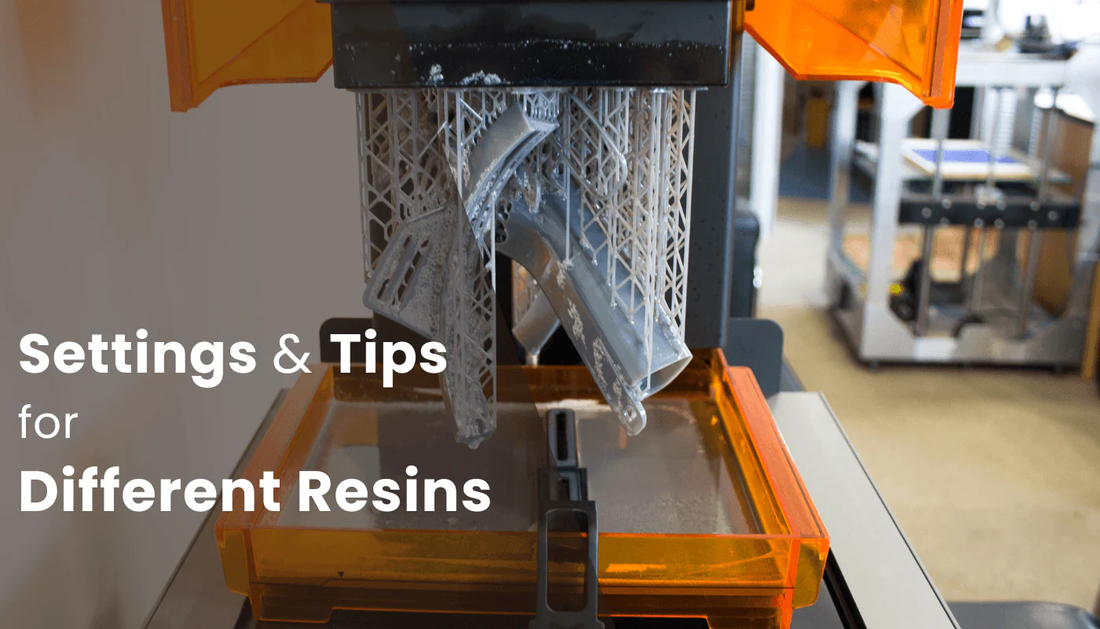
Settings and Tips for Different 3D Printer Resin
Share
3D printing with resin can produce high-quality detailed prints, but getting the best results requires dialing in the right settings and using the resin properly. In this blog post, I'll go over some key data and settings you should understand about your 3D printer resin.
When choosing a resin, you need to understand its properties. Key data to look for includes:
Viscosity - This impacts how easily the resin flows and how it spreads on each layer. Lower viscosity resins can produce finer details.
Curing time - Faster curing resins reduce print time but can be harder to work with. Slower curing gives you more time to complete each layer.
Tensile strength - Higher strength numbers mean the printed object will be more durable. This is important for functional prints.
Elongation at break - How far the material stretches before breaking. Higher elongation means more flexibility.
Shore hardness - A measure of softness or rigidity. Harder resins hold fine details better. Softer resins are good for elastic items.
Temperature resistance - The temperature range the printed object can withstand. Important for any prints that will experience heating.
| Standard Resin | Surface hardness | (Shore D) | 70-80 | |
| Body contraction | (%) | 6-8 | ||
| Tensile strength | (MPa) | 20-35 | ||
| Elongation at break | (%) | 15-25 | ||
| Bending strength | (Mpa) | 20-40 | ||
| Flexural modulus | (Mpa) | 600-800 | ||
| Bottom exposure | (s) | RGB Panel: 20-80 | Mono Panel: 10-60 | |
| Bottom layers | 3-5 | |||
| Normal exposure | (s) | RGB Panel: 4-15 | Mono Panel: 1.5-4 | |
| Lifting height | (mm) | 6-10 | ||
| Lifting speed | (mm/min) | 60-90 | ||
| Falling speed | (mm/min) | 120-180 | ||
| Standard Plus Resin | Surface hardness | (Shore D) | 80-84 | |
| Body contraction | (%) | 7-9 | ||
| Tensile strength | (MPa) | 33 | ||
| Elongation at break | (%) | 15 | ||
| Bending strength | (Mpa) | 35 | ||
| Flexural modulus | (Mpa) | 1225 | ||
| Bottom exposure | (s) | RGB Panel: 30-80 | Mono Panel: 20-60 | |
| Bottom layers | 3-5 | |||
| Normal exposure | (s) | RGB Panel: 4-15 | Mono Panel: 1.5-3 | |
| Lifting height | (mm) | 6-10 | ||
| Lifting speed | (mm/min) | 60-120 | ||
| Falling speed | (mm/min) | 120-180 | ||
| ABS-like Resin | Surface hardness | (Shore D) | 70-80 | |
| Body contraction | (%) | 6-8 | ||
| Tensile strength | (MPa) | 20-35 | ||
| Elongation at break | (%) | 15-25 | ||
| Bending strength | (Mpa) | 20-40 | ||
| Flexural modulus | (Mpa) | 600-800 | ||
| Bottom exposure | (s) | RGB Panel: 20-80 | Mono Panel: 10-60 | |
| Bottom layers | 3-5 | |||
| Normal exposure | (s) | RGB Panel: 4-15 | Mono Panel: 1.5-4 | |
| Lifting height | (mm) | 6-10 | ||
| Lifting speed | (mm/min) | 60-90 | ||
| Falling speed | (mm/min) | 120-180 | ||
| PA-like Resin | Surface hardness | (Shore D) | 75-80 | |
| Body contraction | (%) | 7-9 | ||
| Tensile strength | (MPa) | 20-45 | ||
| Elongation at break | (%) | 20-50 | ||
| Bending strength | (Mpa) | 25-50 | ||
| Flexural modulus | (Mpa) | 650-900 | ||
| Bottom exposure | (s) | RGB Panel: 20-80 | Mono Panel: 10-60 | |
| Bottom layers | 3-5 | |||
| Normal exposure | (s) | RGB Panel: 4-15 | Mono Panel: 1.5-4 | |
| Lifting height | (mm) | 6-10 | ||
| Lifting speed | (mm/min) | 60-90 | ||
| Falling speed | (mm/min) | 120-180 | ||
| Plant-based Resin | Surface hardness | (Shore D) | 80-85 | |
| Body contraction | (%) | 7-9 | ||
| Tensile strength | (MPa) | 20-35 | ||
| Elongation at break | (%) | 5-12 | ||
| Bending strength | (Mpa) | 20-40 | ||
| Flexural modulus | (Mpa) | 600-800 | ||
| Bottom exposure | (s) | RGB Panel: 20-80 | Mono Panel: 10-60 | |
| Bottom layers | 3-5 | |||
| Normal exposure | (s) | RGB Panel: 5-15 | Mono Panel: 2-4 | |
| Lifting height | (mm) | 6-10 | ||
| Lifting speed | (mm/min) | 60-120 | ||
| Falling speed | (mm/min) | 120-180 | ||
| Water-washable Resin | Surface hardness | (Shore D) | 80-85 | |
| Body contraction | (%) | 6-8 | ||
| Tensile strength | (MPa) | 30-50 | ||
| Elongation at break | (%) | 8-14 | ||
| Bending strength | (Mpa) | 35-55 | ||
| Flexural modulus | (Mpa) | 800-1100 | ||
| Bottom exposure | (s) | RGB Panel: 30-80 | Mono Panel: 10-60 | |
| Bottom layers | 3-5 | |||
| Normal exposure | (s) | RGB Panel: 4-12 | Mono Panel: 1.5-3.5 | |
| Lifting height | (mm) | 6-10 | ||
| Lifting speed | (mm/min) | 60-120 | ||
| Falling speed | (mm/min) | 120-180 | ||
| High Toughness Resin | Surface hardness | (Shore D) | 68-72 | |
| Body contraction | (%) | 6-8 | ||
| Tensile strength | (MPa) | 20 | ||
| Elongation at break | (%) | 50 | ||
| Bending strength | (Mpa) | 20 | ||
| Flexural modulus | (Mpa) | 829 | ||
| Bottom exposure | (s) | RGB Panel: 20-80 | Mono Panel: 10-60 | |
| Bottom layers | 3-5 | |||
| Normal exposure | (s) | RGB Panel: 10-20 | Mono Panel: 1.5-4 | |
| Lifting height | (mm) | 6-10 | ||
| Lifting speed | (mm/min) | 60-120 | ||
| Falling speed | (mm/min) | 120-180 | ||
| High Temperature Resin | Surface hardness | (Shore D) | 86-90 | |
| Body contraction | (%) | 6-8 | ||
| Tensile strength | (MPa) | 40-55 | ||
| Elongation at break | (%) | 6-12 | ||
| Bending strength | (Mpa) | 50-65 | ||
| Flexural modulus | (Mpa) | 1300-2000 | ||
| Bottom exposure | (s) | RGB Panel: 20-80 | Mono Panel: 10-60 | |
| Bottom layers | 3-5 | |||
| Normal exposure | (s) | RGB Panel: 10-20 | Mono Panel: 3-5 | |
| Lifting height | (mm) | 6-10 | ||
| Lifting speed | (mm/min) | 60-120 | ||
| Falling speed | (mm/min) | 120-180 | ||
Tips
1. Shake the resin bottle thoroughly before each use, inverting it back and forth at least 3 times. Do not use or expose resin to direct sunlight.
2. Keep resin away from children at all times. Always wear gloves when handling resin to prevent skin contact. Ensure proper ventilation when working with resin. Avoid resin contact with eyes. If resin enters eyes, immediately rinse with plenty of water and seek medical attention if discomfort continues.
3. After printing, wash models with 95% isopropyl alcohol or higher concentration. Use a brush to clean intricate details. For water washable resins, rinse under water for 1-2 minutes. For highly detailed prints, use an ultrasonic cleaner for 1-2 minutes to achieve optimal results. Allow models to dry fully before handling, using a hair dryer to speed up drying time. Finally, post-cure models under UV light for maximum material properties.
4. Never pour used resin from the printer vat back into the original bottle, as this can contaminate the unused resin. Also do not leave resin sitting in the printer vat for extended periods when not in use. For long-term resin storage, transfer to a sealed container and keep away from light to prevent premature curing.
5. Store resin bottles away from light sources at room temperature between 15-35°C / 59-95°F. Cold temperatures can increase resin viscosity.
6. Keep resin bottles tightly sealed during storage to prevent dust and moisture exposure, which can reduce print quality.
Getting to know your resin's properties and fine tuning printer settings gives you the best shot at high quality resin prints. Let me know if you have any other questions!
